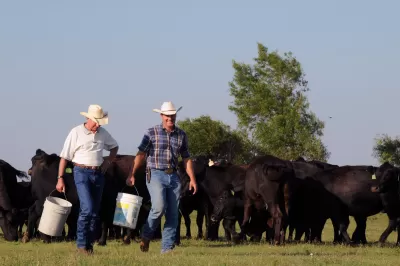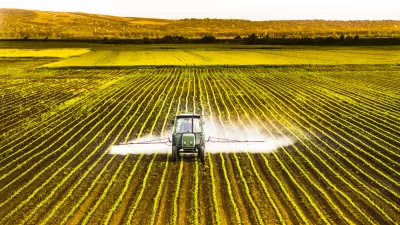With world population to grow by about 2 billion by 2050, and with more people eating higher on the food chain as nations develop economically, can world agriculture reduce its carbon footprint? A new World Resources Institute report shows how.

“Food is the mother of all sustainability challenges,” says Janet Ranganathan, vice president for science and research at the World Resources Institute (WRI), a global research organization. “We can’t get below 2 degrees Celsius without major changes to this system.”
She says that’s why the group’s report, Creating A Sustainable Food Future, released Dec. 5, 2018, is “one of the most important...that we’ve ever published," reports Jenny Splitter for Forbes.
Its authors set out to answer the most critical question facing the global food system today: how to feed the nearly 10 billion people expected to populate the earth by 2050 [up from almost 7.7 billion people today] in a way that doesn’t completely wreck the planet.
"Agriculture already occupies roughly 40 percent of the world’s land and is responsible for about a quarter of humanity’s greenhouse gas emissions," adds Brad Plumer for The New York Times's climate team in his piece on the WRI report.
"Increasing the amount of food produced per hectare was the most critical step, the experts said, followed by cutting meat-eating and putting a stop to the wasting of one-third of food produced," reports Damian Carrington, the Guardian's environment editor.
Chicken is not meat, or at least not "ruminant meat"
Restricting meat-eating need not mean becoming a vegetarian, though Carrington did pen a column on Dec. 22, "Why I’m looking forward to my first vegan Christmas."
“We could imagine a significant shift from beef to chicken, and that by itself goes a long way," said lead author Timothy D. Searchinger of Princeton University. “Poultry production has about one-eighth the climate impact of beef production," adds Plumer.
"According to Searchinger, WRI is recommending 'that two million heavy consumers of meat, lamb and goat in 2050 in the U.S., Russia, Europe, and Brazil, limit their consumption to 1.5 servings per person per week,' so the world can meet its overall reduction goals while, at the same time, acknowledging that 'the world’s poor people are entitled to consume at least a little more',” adds Splitter.
"Ruminant livestock (cattle, sheep, and goats) use two-thirds of global agricultural land and contribute roughly half of agriculture’s production-related emissions," states the executive summary [pdf]. "Ruminant meat demand is projected to grow by 88 percent between 2010 and 2050."
"Avoiding meat and dairy is ‘single biggest way’ to reduce your impact on Earth," reported Carrington of the Guardian on a study published in Science on June 1 that corroborated the outsized impacts of ruminants.
Not by efficiency alone
While efficiency—producing more food on less land, was the report's most critical finding, it recommended tying it to conservation, notes Splitter.
In order to protect natural resources even as farms become more efficient, Searchinger says “governments need to explicitly link...yield gains to protection of forests and other natural lands.” Through government regulation, natural ecosystems can be protected and agricultural expansion, when necessary, can be limited to avoid sacrificing resource-rich lands like tropical rainforests."
The report also looked at human population growth to reduce food demand "by reducing fertility levels, voluntarily, through 'improving education for girls, reducing child mortality and providing access to reproductive health services'," adds Splitter. Presumably this recommendation would be applicable to developing nations in Africa which have the world's highest fertility rates, unlike many economically developed nations where they have fallen below replacement levels.
FULL STORY: How To Feed The World Sustainably? Grow More With Less, New Study Finds

Manufactured Crisis: Losing the Nation’s Largest Source of Unsubsidized Affordable Housing
Manufactured housing communities have long been an affordable housing option for millions of people living in the U.S., but that affordability is disappearing rapidly. How did we get here?

Americans May Be Stuck — But Why?
Americans are moving a lot less than they once did, and that is a problem. While Yoni Applebaum, in his highly-publicized article Stuck, gets the reasons badly wrong, it's still important to ask: why are we moving so much less than before?

Research Shows More Roads = More Driving
A national study shows, once again, that increasing road supply induces additional vehicle travel, particularly over the long run.

Judge Halts Enforcement of Anti-Homeless Laws in Grants Pass
The Oregon city will be barred from enforcing two ordinances that prosecute unhoused residents until it increases capacity and accessibility at designated camping sites.

Advancing Sustainability in Los Angeles County Schools
The Los Angeles County Office of Education’s Green Schools Symposium brings together educators, students, and experts to advance sustainability in schools through innovative design, climate resilience strategies, and collaborative learning.

Using Old Oil and Gas Wells for Green Energy Storage
Penn State researchers have found that repurposing abandoned oil and gas wells for geothermal-assisted compressed-air energy storage can boost efficiency, reduce environmental risks, and support clean energy and job transitions.
Urban Design for Planners 1: Software Tools
This six-course series explores essential urban design concepts using open source software and equips planners with the tools they need to participate fully in the urban design process.
Planning for Universal Design
Learn the tools for implementing Universal Design in planning regulations.
City of Moreno Valley
Institute for Housing and Urban Development Studies (IHS)
City of Grandview
Harvard GSD Executive Education
NYU Wagner Graduate School of Public Service
City of Cambridge, Maryland
Newport County Development Council: Connect Greater Newport





























